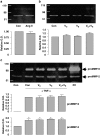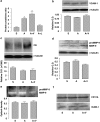Failure of antioxidants to protect against angiotensin II-induced aortic rupture in aged apolipoprotein(E)-deficient mice
- PMID: 17828285
- PMCID: PMC2078223
- DOI: 10.1038/sj.bjp.0707449
Failure of antioxidants to protect against angiotensin II-induced aortic rupture in aged apolipoprotein(E)-deficient mice
Abstract
Background and purpose: Oxidative stress may be involved in the development of abdominal aortic aneurysms (AAAs). Previous studies indicate that antioxidants protect against AAA formation during chronic angiotensin (Ang) II infusion in apolipoprotein E-deficient (ApoE(0)) mice. We here examine if these protective effects also occurred in aged ApoE(0) mice.
Experimental approach: Male ApoE(0) mice (50-60 weeks) were randomly divided into 4 groups: saline, Ang II (1000 ng kg(-1) min(-1) for 4 weeks), Ang II plus antioxidants (0.1% vitamin E in food plus 0.1% vitamin C in drinking water), and Ang II plus losartan (30 mg kg(-1) day(-1)).
Key results: Exogenous Ang II increased systolic blood pressure by 40 mmHg and resulted in the formation of pseudoaneurysms (rupture and extramural haematoma) in the abdominal aorta in 50% of animals. True aneurysmal dilatation was rarely observed. Antioxidants decreased systemic oxidative stress (plasma malondialdehyde), but had only minor effects on aortic rupture, relative to the complete prevention by losartan. Immunohistochemistry revealed strong matrix metalloproteinase-9 (MMP-9) expression in atherosclerotic plaques and at the sites of rupture. Antioxidants did not affect tumour necrosis factor-alpha-stimulated MMP-9 release from U937 cells. In addition, antioxidants had little effects on Ang II-induced renal dysfunction.
Conclusions and implications: In contrast to previous findings in younger mice, antioxidants had only minor effects on Ang II-induced aortic rupture in aged mice. Our results demonstrate that the pathological features of the aneurysmal remodelling induced by Ang II in old ApoE(0) mice are distinct from those of human AAA.
Figures






References
-
- Agarwal R, Campbell RC, Warnock DG. Oxidative stress in hypertension and chronic kidney disease: role of angiotensin II. Semin Nephrol. 2004;24:101–114. - PubMed
-
- Aizawa T, Ishizaka N, Taguchi J, Nagai R, Mori I, Tang SS, et al. Heme oxygenase-1 is upregulated in the kidney of angiotensin II-induced hypertensive rats: possible role in renoprotection. Hypertension. 2000;35:800–806. - PubMed
-
- Araujo M, Welch WJ. Oxidative stress and nitric oxide in kidney function. Curr Opin Nephrol Hypertens. 2006;15:72–77. - PubMed
-
- Arenas IA, Xu Y, Lopez-Jaramillo P, Davidge ST. Angiotensin II-induced MMP-2 release from endothelial cells is mediated by TNF-alpha. Am J Physiol Cell Physiol. 2004;286:C779–C784. - PubMed
-
- Bellosta S, Via D, Canavesi M, Pfister P, Fumagalli R, Paoletti R, et al. HMG-CoA reductase inhibitors reduce MMP-9 secretion by macrophages. Arterioscler Thromb Vasc Biol. 1998;18:1671–1678. - PubMed
Publication types
MeSH terms
Substances
LinkOut - more resources
Full Text Sources
Medical
Miscellaneous

